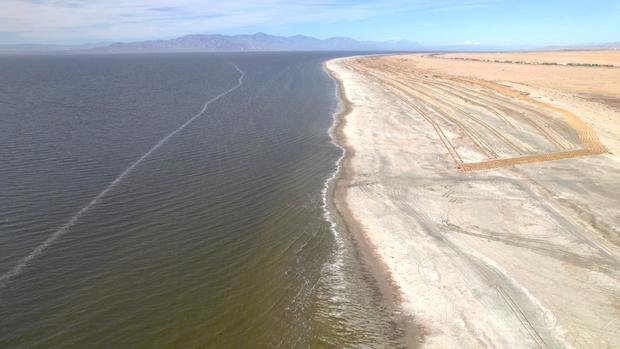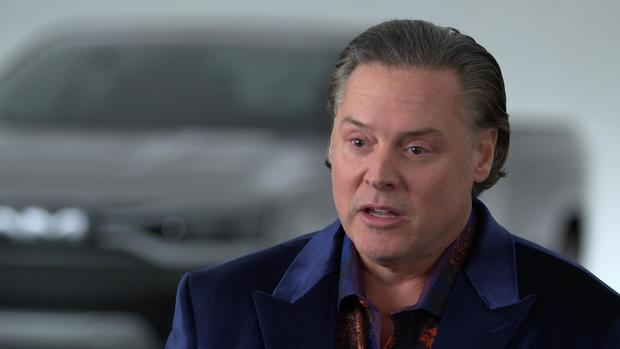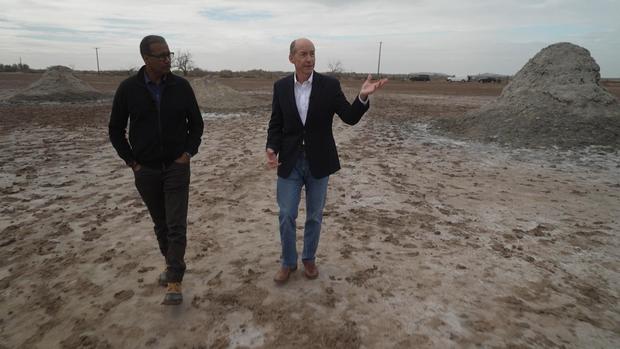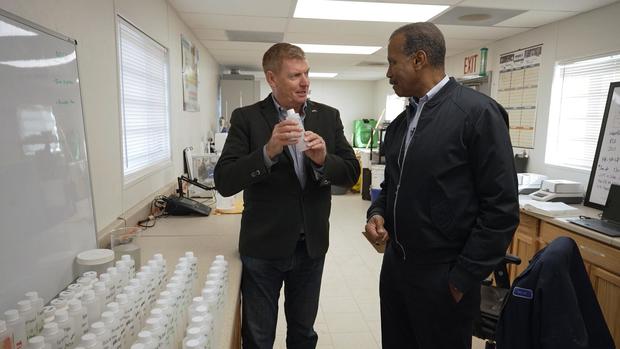Companies develop lithium extraction for batteries in California as U.S. auto industry goes electric
The transition from fossil fuels to sustainable electric power has gone mainstream, most visibly in the auto industry. The major car companies are chasing Tesla with ambitious plans for fleets of electric vehicles. Those cars and trucks run on lithium batteries.
The U.S. has massive quantities of lithium, but has been slow to invest in the mining and extraction of the metal. That's about to change.
Lithium operations powered by clean energy are being developed in a long neglected, impoverished part of California by the Salton Sea, not far from the Mexican border.
The region is being called Lithium Valley and just like the 1849 Gold Rush, companies are racing to strike it rich.
East of San Diego and south of Palm Springs lies the Salton Sea - California's largest inland body of water.
Eric Spomer: It is a world-class lithium resource.
Bill Whitaker: This is?
Eric Spomer: When you hear estimates of how big this resource could be, it's usually measured on annual tons produced. And we're confident that this is in excess of 300,000 tons a year. Right now, that's way more than half of the world supply of lithium.
Eric Spomer is CEO of EnergySource Minerals, a company based by the Salton Sea in California's Imperial Valley. It's steaming ahead with plans to recover lithium using an existing electric plant, powered by the vast, underground geothermal field.
Bill Whitaker: We're moving into an era of green technology, especially with our cars. Where does this fit in?
Eric Spomer: Our more conservative projection would support seven and a half million electric vehicles a year, which is half of the total U.S. car sales, cars and trucks.
Bill Whitaker: Coming from the Salton Sea area?
Eric Spomer: Correct.
Bill Whitaker: What about this plant?
Eric Spomer: This plant will be 20,000 tons per year, which is equivalent to about 500,000 vehicles per year.
Once up and running, the tons of lithium generated here will be shipped, refined, and processed into millions of rechargeable electric car batteries.
Mark Stewart: Over 50% of our lineup and our retail sales will be from battery electric vehicles by the end of the decade.
Mark Stewart is head of Stellantis North America – a global carmaker that owns some of America's best known brands, including Chrysler, Jeep and Ram trucks.
Mark Stewart: It really is quote-unquote "the industrial revolution" the next phase, right? This is the most interesting and exciting time to be a part of our industry.
Stellantis is investing $35 billion in an ambitious, historic transformation.
Mark Stewart: We're reimagining our factories -- on our assembly plants. They're already rolling our plug-in hybrids as well as looking to two new battery joint ventures that are in con-- full construction right now.
Bill Whitaker: The new industrial revolution.
Mark Stewart: It absolutely is. It's really the, the biggest technological changes in our industry in nearly 100 years.
Bill Whitaker: We were down in the Salton Sea region, they believe they can supply the lithium needs for all American car manufacturers.
Mark Stewart: Absolutely, that is the case.
Bill Whitaker: Whatever they can produce, you guys will be buying it?
Mark Stewart: We for sure will take as much as we can get and as much as we have, we have already secured early.
Lithium is key to powering electric cars. The dense metal helps make batteries rechargeable. There's a lot of it around, but extracting lithium is dirty business. Most comes from rock mines in Australia, or as powder evaporated from mineral ponds in South America. The U.S. has one lithium evaporation plant in Nevada. EnergySource plans to break ground on a clean, billion dollar facility here by the Salton Sea in the next few months.
Bill Whitaker: So the plant will fit in this spot right here?
Eric Spomer: Correct. That spot right there.
Bill Whitaker: That's not a big, that's not a big footprint.
Eric Spomer: No.
Bill Whitaker: What are these?
Eric Spomer: We call them the mud pots. And they are CO2 vents-- hot CO2 with fluid that's bubbling to the surface.
Bill Whitaker: So this is evidence of the heat and activity going on underground?
Eric Spomer: Correct.
The 600-degree geothermal brine that powers the region's electric plants comes from more than a mile beneath the earth. The boiling brine produces clean steam, which drives turbines to generate enough electricity to power 400,000 homes. In the past, the mineral-rich brine was simply returned to the earth. Now EnergySource plans to extend the process and extract lithium from the brine before reinjecting it underground.
Eric Spomer: Our process in combination with this resource, will be the cleanest, most efficient lithium process in the world.
Bill Whitaker: And how long before the lithium processed here will be in commercial use in the U.S.?
Eric Spomer: In 2025.
David Deak: A lot of the components that go into the batteries have been coming from, you know, anywhere around the world but America.
Bill Whitaker: Why was that?
David Deak: We have a lot of decent resources in North America, they've just been undeveloped.
David Deak worked for Tesla, traveling the world to find the best sources of lithium as it was building up production of its electric vehicles, or EVs. Tesla turned to the lithium-ion battery to power its cars, the same kind of rechargeable battery Sony first mass-produced for its camcorders.
David Deak: There was a new market for consumer electronics. But the vast majority is for electric vehicles.
Bill Whitaker: And that was pretty much triggered by Tesla?
David Deak: Triggered by Tesla. Also, you know, there's a lot of EV growth and EV demand and production in, in China. That's been a big part of, big part of the global lithium demand story.
Deak is now EnergySource's chief development officer, and says he had a eureka moment when he saw its unique technology.
At the company's lab, Deak showed us the mechanics in miniature. The full-sized plant will be 100 times larger.
Bill Whitaker: So what goes on inside this cylinder? Is it pellets? Or what, what is the matrix--
David Deak: Yeah. Think of it as beads in a column, much like the activated carbon that you would find in a Brita filter. It works in a, in a similar concept. A Brita filter will filter all impurities out of water. This sorbent is something that would only take in lithium, and not absorb everything else.
The system takes just a few hours to turn this orange brine into this clear lithium solution, which will be dried into powder.
Bill Whitaker: And this is what everybody's looking for.
David Deak: That's what everyone wants.
Here by the Salton Sea, EnergySource is leading the race for lithium. Warren Buffett's BHE Renewables runs 10 geothermal power plants in the region. And there's another on the drawing board by an Australian company - Controlled Thermal Resources. Both ventures are moving to tap the promise bubbling under the earth.
CEO Rod Colwell told us Controlled Thermal Resources had been fine-tuning the process at this test facility for 90 days.
Rod Colwell: We're producing lithium from live brine here behind us. This is our optimization plant.
Based on what it learns here, Controlled Thermal Resources plans to build a new plant for recovering lithium, which costs about $4,000 a ton to extract and currently is selling for six times more.
The noise is from the machines cooling 600-degree brine rising from the well, releasing steam.
Rod Colwell: This is a battery grade product from Salton Sea brine.
Bill Whitaker: This for you is Eureka?
Rod Colwell: This is absolutely Eureka, yes.
Rod Colwell told us this bottle of clear lithium chloride is the purest product from this test facility so far.
Rod Colwell: This is the first time this has been in my hands since it happened last night, Bill. So that's-- I might take that home with me. That's about $10 worth of lithium right there. So…
Bill Whitaker: You know it works.
Rod Colwell: We know it works.
The question here in the Salton Sea Basin is will it work for everyone? This rich lithium resource lies beneath one of the poorest sections of California.
The Salton Sea was created when the Colorado River flooded the basin in 1905, but for the past 50 years the main source of water has been chemical-laden agricultural runoff and for decades now the sea has been evaporating and shrinking. A once thriving tourist industry has been replaced by environmental decay, toxic dust and economic hardship. And with unemployment in the region hovering around 16%, there's a lot riding on turning the Imperial Valley into Lithium Valley.
Frank Ruiz: Governor Newsom called it, you know, the Saudi Arabia of lithium. I think, you know, it can change the landscape of the region.
Frank Ruiz, the Audubon Society's local program director, is fighting to include the community in that change. He was a commissioner on the state panel studying how the entire region can benefit from the potential underground.
Bill Whitaker: You're an environmentalist. How do you reconcile the industrialization of this area with saving the wildlife and the communities?
Frank Ruiz: We need to learn how to balance the tables. The lithium industry can be really good, you know, for these communities. It can, you know, it can provide better paid jobs. It can provide more job opportunities, especially for the younger folks. It can provide the revenues, you know, to offset the challenges that we have here at the Salton Sea.
Geologists predict once the industry is fully operational, the lithium underground should last for generations before running out. Good news for Stellantis which ran out of batteries for its plug-in hybrid Jeep Wrangler last year.
Mark Stewart: We sold out.
Bill Whitaker: What happened?
Mark Stewart: The uh-- if I could turn back my crystal ball, Bill, I would have secured a little more capacity for, for last year.
To prevent that from happening in the future, Mark Stewart and Stellantis have committed to buying lithium from Controlled Thermal Resources at the Salton Sea, knowing it will be years before its product is commercially viable.
Mark Stewart: We secured a large supply from them over a ten-year period—because we are very positive on their technology.
So is carmaker General Motors, which has invested in Controlled Thermal Resources. The Department of Energy and U.S. auto makers are eager for domestic lithium. The companies were stung when the pandemic disrupted the world-wide supply chain, stalling shipments of microchips, parts and batteries. Still today, three quarters of all lithium batteries are processed in Asia.
Bill Whitaker: So will having this domestic supply of lithium help keep the cost of electric vehicles down?
Mark Stewart: It will certainly help.
Prices for electric cars are coming down and are projected to be on par with gas vehicles within a few years, driven in part by the tax incentives in the 2022 Inflation Reduction Act. Eric Spomer of EnergySource told us the tax benefits have also been a catalyst for developing domestic lithium.
Eric Spomer: We're starting to see big announcements of investments to create that domestic demand so it doesn't ever have to go across an ocean.
Bill Whitaker: This seems like this is a game changer for American industry?
Eric Spomer: It's a competitive advantage. It's an opportunity that we can be a leader globally. And why not lead?
Produced by Sara Kuzmarov. Associate producer, Mabel Kabani. Broadcast associate, Natalie Breitkopf. Edited by Matt Richman.









